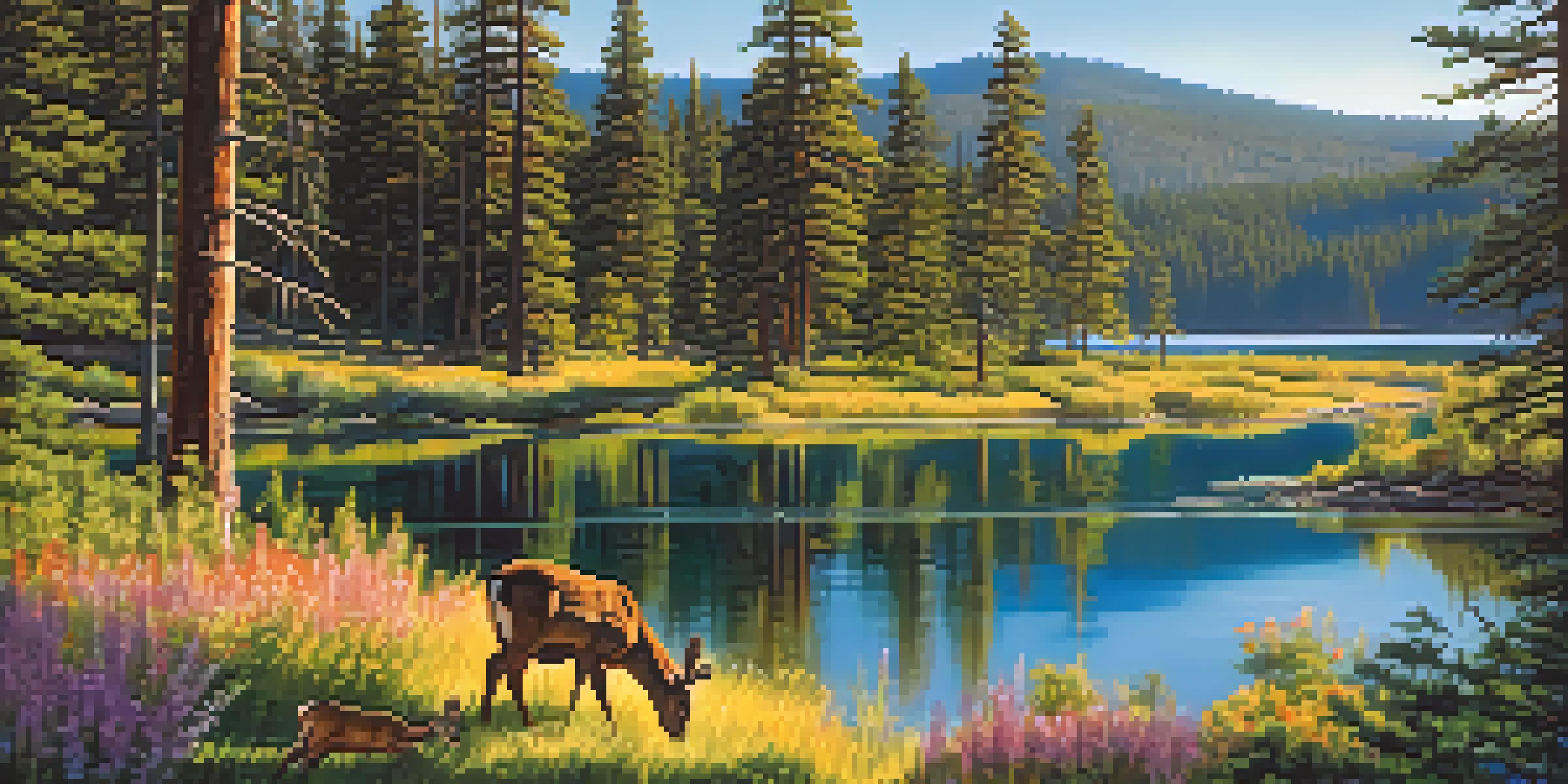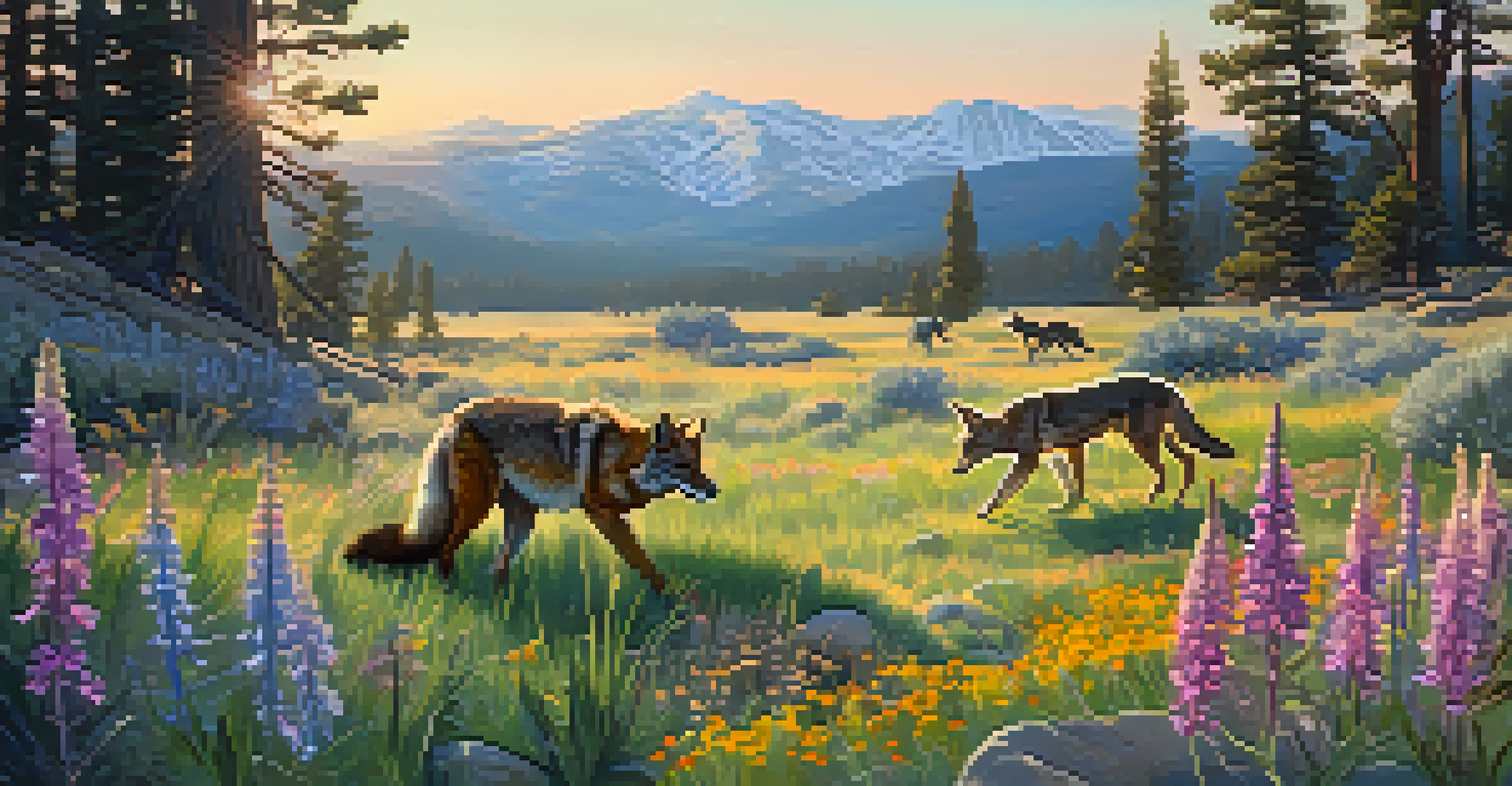The Role of Habitat in Big Bear's Wildlife Diversity

Understanding Big Bear's Unique Ecosystem
Big Bear Lake, located in the San Bernardino Mountains, hosts a unique ecosystem that supports a variety of wildlife. Its diverse habitats, including forests, meadows, and wetlands, create an ideal environment for numerous species. Each habitat type contributes to the overall biodiversity, making Big Bear a haven for nature lovers and wildlife enthusiasts alike.
In every walk with nature one receives far more than he seeks.
The interplay between elevation, climate, and geography further enriches this area. For example, the cooler temperatures at higher altitudes foster coniferous forests, while lower elevations may feature chaparral and grasslands. This variety in habitat types allows different species to thrive, promoting a rich tapestry of life.
Moreover, the seasonal changes in Big Bear enhance its ecological diversity. From blooming wildflowers in spring to the vibrant fall foliage, these shifts not only attract visitors but also provide essential resources for wildlife. The dynamic nature of this ecosystem makes it a fascinating subject for study and exploration.
The Impact of Forests on Wildlife Habitats
Forests play a crucial role in supporting Big Bear's wildlife diversity. They provide shelter, food, and breeding grounds for numerous species ranging from birds to mammals. The dense canopy and underbrush create a complex habitat that offers diverse niches for animals to occupy.

For instance, species like black bears and mule deer rely heavily on forested areas for their survival. The abundance of acorns, berries, and vegetation in these regions ensures that wildlife has access to the nutrients they need. Furthermore, forests also serve as corridors, allowing animals to move safely between different areas.
Big Bear's Diverse Ecosystems
Big Bear Lake's unique ecosystems, including forests, wetlands, and meadows, support a rich variety of wildlife and promote biodiversity.
However, these forest habitats face challenges from climate change and human activities. Preserving these vital ecosystems is crucial, as they are essential not only for wildlife but also for maintaining the overall health of the environment. Conservation efforts are necessary to ensure that these forests continue to thrive.
Wetlands: Essential for Biodiversity
Wetlands in Big Bear are often overlooked, yet they are vital for sustaining wildlife diversity. These areas act as natural filters, improving water quality while providing a habitat for amphibians, birds, and other aquatic life. The presence of water attracts a multitude of species, making wetlands hotspots for biodiversity.
The environment is where we all meet; where we all have a mutual interest; it is the one thing all of us share.
For example, migratory birds rely on wetlands as resting and feeding grounds during their long journeys. They provide rich resources, such as insects and plants, essential for replenishing energy. Additionally, wetlands serve as breeding grounds for various species, contributing to the overall health of wildlife populations in the region.
However, wetlands are sensitive to environmental changes and human encroachment. Protecting these crucial habitats is essential to maintain the delicate balance of Big Bear's ecosystem. Active conservation and restoration efforts can help safeguard these vital areas for future generations.
The Role of Meadows in Supporting Wildlife
Meadows in Big Bear offer a different kind of habitat that is equally important for wildlife diversity. These open spaces provide a rich source of food, including grasses, wildflowers, and shrubs, attracting various herbivores. This, in turn, supports a range of predators that rely on these animals for sustenance.
For instance, species like coyotes and foxes can be frequently spotted in meadows, hunting for small mammals and birds. The open environment allows for easy movement, making it a preferred hunting ground. Additionally, meadows are crucial for pollinators, such as bees and butterflies, which help maintain plant diversity.
Human Impact on Wildlife
Human activities such as urbanization and tourism threaten wildlife habitats in Big Bear, emphasizing the need for responsible practices and conservation.
The seasonal blooming of wildflowers in meadows also adds to the area's beauty and ecological richness. These vibrant displays not only attract visitors but also serve as vital resources for numerous species. Protecting meadows is essential for ensuring the continued health of Big Bear's wildlife.
Mountainous Terrain and Its Wildlife
The mountainous terrain surrounding Big Bear presents unique challenges and opportunities for wildlife. The rugged landscape creates distinct habitats that support various species adapted to these conditions. From steep slopes to rocky outcrops, this environment is home to animals such as mountain goats and various bird species.
High elevation areas often experience harsher climates, which shapes the wildlife that can thrive there. Species in these regions must be resilient and adaptable to survive the colder temperatures and limited vegetation. This leads to a fascinating array of wildlife that can be found nowhere else.
Moreover, the mountains act as natural barriers and corridors, influencing animal movement and behavior. Understanding these dynamics is crucial for effective conservation strategies. By preserving these mountainous habitats, we can help ensure the survival of unique species that call Big Bear home.
Human Impact on Wildlife Habitats
Human activities have a significant impact on the wildlife habitats in Big Bear. Urbanization, tourism, and resource extraction can lead to habitat degradation, threatening the delicate balance of this ecosystem. As more people flock to the area for recreation, the pressure on wildlife increases.
For example, the construction of roads and buildings can fragment habitats, making it difficult for animals to move freely. This can lead to decreased genetic diversity and increased competition for resources among species. Additionally, pollution from human waste and runoff can harm sensitive habitats, such as wetlands and meadows.
Importance of Conservation Efforts
Active conservation efforts and community engagement are essential to protect and restore Big Bear's wildlife habitats for future generations.
To mitigate these effects, it's essential to promote responsible tourism and sustainable practices. Educating visitors about the importance of preserving wildlife habitats can foster a culture of respect for nature. By working together, we can ensure that Big Bear remains a thriving sanctuary for its diverse wildlife.
Conservation Efforts in Big Bear
Conservation efforts play a vital role in protecting the wildlife diversity of Big Bear. Numerous organizations and local initiatives work tirelessly to safeguard habitats and promote sustainable practices. These efforts are crucial in ensuring that future generations can enjoy the rich biodiversity that Big Bear has to offer.
For instance, habitat restoration projects aim to rehabilitate areas affected by human impact. This can include replanting native vegetation, removing invasive species, and creating wildlife corridors. Such initiatives not only benefit wildlife but also enhance the overall health of the ecosystem.

Additionally, community engagement is key to successful conservation. Involving local residents and visitors in conservation programs fosters a sense of stewardship for the land. By empowering individuals to take action, we can collectively work towards preserving the unique wildlife diversity of Big Bear.
The Future of Wildlife in Big Bear
The future of wildlife in Big Bear largely depends on our collective efforts to protect their habitats. As climate change and human activities continue to pose threats, proactive measures are essential. By understanding the importance of each habitat type, we can develop strategies that promote resilience and adaptability among wildlife.
Moreover, ongoing research and monitoring can provide valuable insights into how wildlife populations respond to environmental changes. This information can guide conservation efforts, ensuring that they are effective and targeted. Engaging the community and raising awareness about these issues will also be crucial for long-term success.
Ultimately, the health of Big Bear's wildlife is intertwined with the health of its habitats. By prioritizing conservation and responsible stewardship, we can help maintain the rich biodiversity of this beautiful region for generations to come.